
Senecio is a genus of flowering plants in the daisy family (Asteraceae) that includes ragworts and groundsels.

Senecioneae is the largest tribe of the Asteraceae, or the sunflower family, comprising over 150 genera and over 3,500 species. Almost one-third of the species in this tribe are placed in the genus Senecio. Its members exhibit probably the widest possible range of form to be found in the entire plant kingdom, and include annuals, minute creeping alpines, herbaceous and evergreen perennials, shrubs, climbers, succulents, trees, and semi-aquatic plants.

The cinnabar moth is a brightly coloured arctiid moth found as a native species in Europe and western and central Asia then east across the Palearctic to Siberia to China. It has been introduced into New Zealand, Australia and North America to control ragwort, on which its larvae feed. The moth is named after the red mineral cinnabar because of the red patches on its predominantly black wings. The species was first described by Carl Linnaeus in his 1758 10th edition of Systema Naturae. Cinnabar moths are about 20 mm (0.79 in) long and have a wingspan of 32–42 mm (1.3–1.7 in).
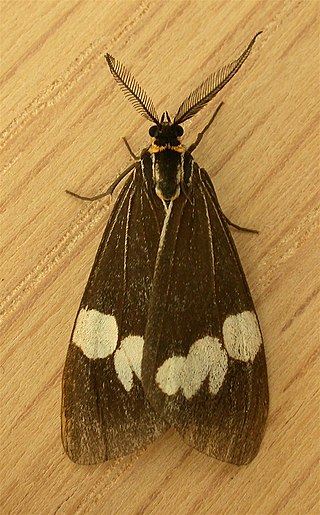
Nyctemera amicus, the senecio moth, magpie moth or cineraria moth, is a moth of the family Erebidae. The species was first described by Adam White in 1841. It is found in South-east Asia, Oceania, and most of Australia. It can also be found in New Zealand.

Trypeta immaculata is a species of tephritid or fruit flies in the genus Trypeta of the family Tephritidae.

The Alps are one of the great mountain range systems of Europe stretching approximately 1,200 kilometres (750 mi) across eight Alpine countries from Austria and Slovenia in the east, Switzerland, Liechtenstein, Germany, France to the west and Italy and Monaco to the south. The flora of the Alps are diverse. In the mountains, the vegetation gradually changes with altitude, sun exposure, and location on the mountain. There are five successive life zones, each with distinct landscapes and vegetation characteristics: premontane, montane, subalpine, alpine, and alvar.
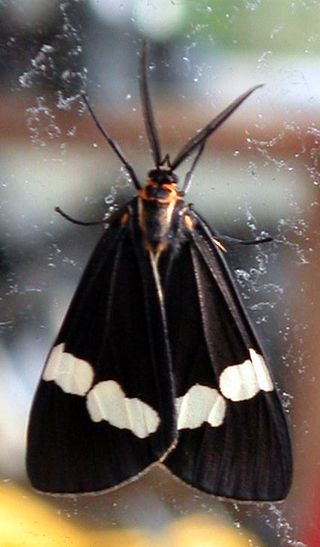
Nyctemera annulata, the magpie moth, is a moth of the family Erebidae. The species was first described by Jean Baptiste Boisduval in 1832. It is endemic to New Zealand and found in all parts of the country.

Hellinsia osteodactyla is a moth of the family Pterophoridae. It is found in most of Europe, as well as North Africa and from Asia Minor to Japan. Also known as the small golden-rod plume it was first described by Philipp Christoph Zeller in 1841.

Stigmella ogygia is a moth of the family Nepticulidae. It is found in New Zealand.
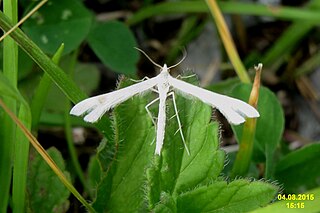
Platyptilia nemoralis is a moth of the family Pterophoridae. It is found from Europe, through Russia to Japan.

Platyptilia calodactyla is a moth of the family Pterophoridae found in Asia and Europe. It was first described by the Austrian entomologists, Michael Denis & Ignaz Schiffermüller in 1775.
Stigmella guittonae is a moth of the family Nepticulidae. It is known from Argentina.
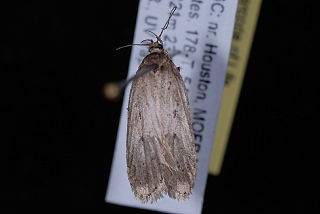
Agonopterix canadensis, the Canadian agonopterix, is a moth of the family Depressariidae. It is found from the north-eastern United States and southern Canada, south through the Rocky Mountains to Colorado, the Basin Range and the mountains of central California and Nevada.

Agonopterix cinerariae is a moth of the family Depressariidae. It is found on the Canary Islands.
Agonopterix doronicella is a moth of the family Depressariidae. It is found in France, Italy, Austria, the Czech Republic, Slovakia, Poland, Hungary, Romania, Bulgaria, North Macedonia, Albania, Bosnia and Herzegovina and Croatia.

Phycitodes albatella is a species of snout moth. It is found in most of Europe, Uzbekistan and North America.
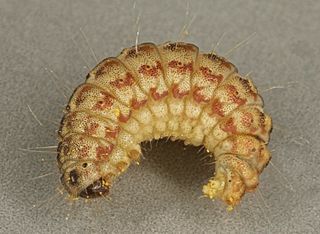
Phycitodes saxicola, the small clouded knot-horn, is a species of snout moth described by Vaughan in 1870. It is found in most of Europe, as well as Iran, Morocco and the Canary Islands.

Commophila aeneana, the orange conch, is a species of moth of the family Tortricidae. It is found in Great Britain, France, Belgium, Luxembourg, the Netherlands, Germany, Austria, Switzerland, Italy and Romania.

Senecio quadridentatus is native to Australia and New Zealand. In New Zealand it is known by its Māori name pahokoraka or pekapeka. Senecio quadridentatus is an annual or perennial herbaceous flowering plant in the family Asteraceae. It is also known as Erechtites quadridentata Labill by the synonyms.
















